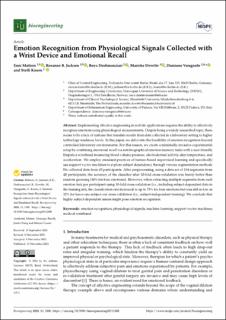| dc.contributor.author | Mattern, Enni | |
| dc.contributor.author | Jackson, Roxanne R. | |
| dc.contributor.author | Doshmanziari, Roya | |
| dc.contributor.author | Dewitte, Marieke | |
| dc.contributor.author | Varagnolo, Damiano | |
| dc.contributor.author | Knorn, Steffi | |
| dc.date.accessioned | 2024-01-12T08:38:16Z | |
| dc.date.available | 2024-01-12T08:38:16Z | |
| dc.date.created | 2023-12-18T14:20:42Z | |
| dc.date.issued | 2023 | |
| dc.identifier.citation | Bioengineering. 2023, 10 (11), . | en_US |
| dc.identifier.issn | 2306-5354 | |
| dc.identifier.uri | https://hdl.handle.net/11250/3111247 | |
| dc.description.abstract | Implementing affective engineering in real-life applications requires the ability to effectively recognize emotions using physiological measurements. Despite being a widely researched topic, there seems to be a lack of systems that translate results from data collected in a laboratory setting to higher technology readiness levels. In this paper, we delve into the feasibility of emotion recognition beyond controlled laboratory environments. For this reason, we create a minimally-invasive experimental setup by combining emotional recall via autobiographical emotion memory tasks with a user-friendly Empatica wristband measuring blood volume pressure, electrodermal activity, skin temperature, and acceleration. We employ standard practices of feature-based supervised learning and specifically use support vector machines to explore subject dependency through various segmentation methods. We collected data from 45 participants. After preprocessing, using a data set of 134 segments from 40 participants, the accuracy of the classifier after 10-fold cross-validation was barely better than random guessing (36% for four emotions). However, when extracting multiple segments from each emotion task per participant using 10-fold cross-validation (i.e., including subject-dependent data in the training set), the classification rate increased to up to 75% for four emotions but was still as low as 32% for leave-one-subject-out cross-validation (i.e., subject-independent training). We conclude that highly subject-dependent issues might pose emotion recognition. | en_US |
| dc.language.iso | eng | en_US |
| dc.publisher | MDPI | en_US |
| dc.rights | Navngivelse 4.0 Internasjonal | * |
| dc.rights.uri | http://creativecommons.org/licenses/by/4.0/deed.no | * |
| dc.title | Emotion Recognition from Physiological Signals Collected with a Wrist Device and Emotional Recall | en_US |
| dc.title.alternative | Emotion Recognition from Physiological Signals Collected with a Wrist Device and Emotional Recall | en_US |
| dc.type | Peer reviewed | en_US |
| dc.type | Journal article | en_US |
| dc.description.version | publishedVersion | en_US |
| dc.source.pagenumber | 0 | en_US |
| dc.source.volume | 10 | en_US |
| dc.source.journal | Bioengineering | en_US |
| dc.source.issue | 11 | en_US |
| dc.identifier.doi | 10.3390/bioengineering10111308 | |
| dc.identifier.cristin | 2214967 | |
| cristin.ispublished | true | |
| cristin.fulltext | original | |
| cristin.qualitycode | 1 | |

